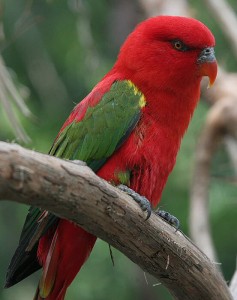Chattering Lory
Chattering Lory is are costal lowlands and upland forest dwelling parrot endemic to North Maluku, Indonesia. They are normally found in pairs and they are very noisy in flight. There are two sub species:
- Yellow-backed Lories
- Morotai Yellow-backed Lories
 They grow to an average height of 30cm and are all dark red in colour with the exception of the wings and thighs which are green.
They grow to an average height of 30cm and are all dark red in colour with the exception of the wings and thighs which are green.
Chattering Lory as a hand raised pet
is large, playful, outgoing and, at times, mischievous. The species has a charming and clownish nature that is always having fun, as it is an active pet bird. These birds often form strong bonds with their owners. Due to their high intelligence, they can be easily trained and this makes them a perfect pet for both singles and families. Chattering Lories are one of the better talking species and perhaps one of the cleverest at escaping or just being all around trouble makers. But on the pother hand they can be very aggressive and difficult to handle for in experienced handlers. Would not recommend this bird for kids as they are more aggressive than most birds when hand raised.
Introducing your new bird to existing birds
Once you take your bird home you should keep it in a separate cage and allow the bird to adjust accordingly. Always allow at least 2 weeks before introducing the bird to an existing bird.
Cage
When selecting a cage, it is important to select the largest cage you can afford, remember the bigger the cage the happier the bird. Chattering Lories are very active birds; you will need room for many toys, perches, food/water dishes, as well as sufficient space for them to move around. Chattering Lories are one of the large species of lories and lorikeets, so will requires a large cage as well as supervised out of cage time.
Select toys that make noise, such as bells and that they can climb, such as ropes. You will need to provide them items for chewing and branches from trees, such as eucalypts, bottlebrush, acacias or Grevillia’s. Branches should be washed before placed in the cage.
Hygiene
The cage requires regulars cleaning and old food shouldn’t be allowed to accumulate in the cage, on perches or in feeders. Water should be changed daily basics.
Worming
Your bird will need to be wormed in a few weeks to two month after being taken home check with the staff from Birdsville, when purchasing). Worming will then need to be done every 6 month.
Lice & Mites
These are the two most common parasites of cage birds and their environment, but are easily controlled with a Mite and Lice spray, available at Birdsville. When using spray, spray bird, entire cage, perches, nesting box and toys, remember to remove all water and
feed and avoid spraying in birds’ eyes.
Diet
Chattering Lories have specialized brush-tipped tongues for feeding on nectar and soft fruits. They can feed from the flowers of about 5,000 species of plants and use their specialised tongues to take the nectar. The tip of their tongues have tufts of papillae (extremely fine hairs), which collect nectar and pollen. Due to this they cannot eat seed like most parrots.
Pet lorikeets require a nectar replacement diet, which are available at Birdsville. These mixes come in powder form and there are two main types of nectar replacement:
- Dry mix (Lorri-dry) – with dry, plenty of fresh drinking water needs to be made available for the bird.
- Wet mix (Lorri-wet) – with wet, their requirements for drinking will be reduced, as the feed contains a large amount of water, however fresh drinking water should still be made available.
Young birds should be feed on both wet and dry mix in separate containers and can later be weaned on to dry mix only.
Chattering Lorries also need their diet supplemented with fresh fruit and vegetables on a daily basis. Spinach or silverbeet leaves are important to provide calcium for the bird, due to the shape of their beak and tongue they will rarely use a cuttlefish. Your bird with also require vitamin mixed into their water every two to three days. This is to provide essential nutrients commonly deficient in their diet.
Do not feed your bird (or any other bird) avocado, onion, chocolate, caffeine or alcohol.
Training
This is an important factor of having a well behaved hand raised bird. The bird need to be handle in a quiet, relxed situation, but don’t over stress your bird in the first few weeks of taking it home. The more time you spend with your bird, the better your bird will become.
Breeding
Chattering Lories are naturally easily to breed. They reach sexual maturity at 2 to 3 years of age and their expected life span is 8+ years provided their specific dietary needs are met. Males and females look alike and breeders depend on DNA or endoscopic sexing to determine their gender.
Found in store, for more details call Birdsville 9667 2555.


